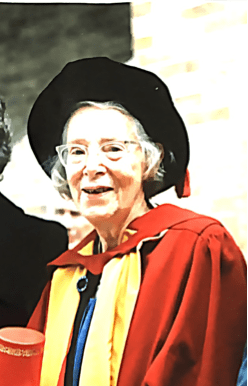Letters hidden in the archive reveal a fascinating 1940s conversation about chromosomes
What is Life? is a classic of twentieth century science writing. The book was written by the Nobel physicist Erwin Schrödinger and published in 1944. In What is Life? The Physical Aspect of the Living Cell Schrödinger brought the worlds of physics and biology together and set the scene for a discussion on chromosomes. According to Schrödinger chromosomes were the “most essential part of a living cell” (Schrödinger, 1944, p. 5).
Irene Manton on encountering the book What is Life?
“when a great physicist takes the trouble to explain in simple language some of his matured thoughts on topics of general interest outside his own subject, it is an event for which one cannot be too grateful….”
Irene Manton, 1945

Irene Manton was Professor of Botany at the University of Leeds (and first ever woman professor at the university). When she discovered What is Life? she wrote a review of book and decided to contact its author. Manton was fascinated with the fact that a Nobel physicist had wondered into her subject of biology. In response to the book she wrote a review published in the journal “Nature” shortly before the end of WWII. The article began “”when a great physicist takes the trouble to explain in simple language some of his matured thoughts on topics of general interest outside his own subject, it is an event for which one cannot be too grateful….”.
A diversity of voices
Nowadays team-working between different subject groups is all the rage. We regularly see such efforts across different sectors. In public health, for example, this can be seen in the One Health approach. Here the goal of achieving optimal health is better realised by adopting a unified approach. One Health recognises the interconnections between people, animals, plants, and the environment. It involves a team-working approach that brings together different voices at the local, regional, national, and global levels.
In mid-twentieth century science this kind approach was unheard of. On the edge of biology and physics the idea team-working was just beginning. This is what makes the conversation between Schrödinger and Manton so fascinating. Their exchange took place when the field of Molecular Biology was just getting started. What is Life? is well-known for the impact it had on molecular biologists. Two examples are those of James Watson and Francis Crick who were involved in the discovery of DNA. The book was also important and influential upon biologists too. We can see this clearly by studying Manton and her past scientific ideas.
Hidden gems in the archives
I first discovered the Schrödinger–Manton letters at the University of Leeds archives. I found them in a unorganised collection. Finding them was like uncovering hidden jewels! I recall the afternoon clearly. I was sitting in the quiet library sifting through papers when I came across a handwritten letter. Seeing a familiar name top right caused me to do a double take. Could this letter really have been penned by the Nobel physicist Erwin Schrödinger? It was an unexpected find. Manton was well-connected. But she was also a British biologist. How did she know Schrödinger? Soon after I discovered another letter at the Dublin Institute of Advanced Studies archive (Schrödinger had moved to Ireland amidst the rise of the Nazi’s in the 1930s). Here was the letter Manton had written to Schrödinger.
The letters chart a fascinating conversation between a biologist and physicist. The pair held very different perspectives. Manton was an evolutionary biologist. She was a life-long microscopist who liked to peer beneath the lens and see things. She enjoyed experimenting with cells and whole organisms. Schrödinger meanwhile was as a theoretical physicists. He was used to working with theories and ideas. The letters chart a discussion between both parties about the nature of chromosomes and genetics. By working together the two scientists were able to uncover new insights. They saw there was potential for storing far more genetical information inside chromosomes than was previously thought.
The original article was first published in September 2015 online and in print in 2016 in the “Journal of the History of Biology”: Nicola Williams (2016) Erwin Schrödinger and the Puzzle of Chromosome Structure. J Hist Biol 49, 425–459 (2016). https://doi.org/10.1007/s10739-015-9424-5.
Here is a link to the original article.